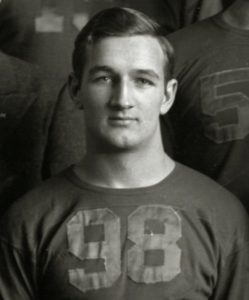
Tom Harmon played football for the University of Michigan, at a game seen at Northwestern by Tom Cartmell’s father. He became a Heisman Trophy winner and later entered the Army Air Force.
Tom Harmon’s friend and former team mate from Michigan was Harold “Tippy” Lockard. Tippy was Tom Cartmell’s physical training and calisthenics instructor at Santa Ana Army Air Base in southern California in 1943.
From the New York Times Obituary:
He was voted to all-America teams as a junior and senior and in 1940 was awarded the Heisman, Maxwell and Walter Camp trophies.
When he accepted the Heisman Trophy as the nation’s outstanding collegiate football player, Harmon stated that he had no intention of playing professionally. He majored in speech at Michigan and his goal was to be a radio announced. But after his graduation, his first assignment was to star in a film loosely based on his career. The movie, ”Harmon of Michigan,” paid for a new home for his parents in Ann Arbor, Mich., but failed to impress movie critics or the viewing public.
Harmon was selected first in the 1941 National Football League draft by the Chicago Bears, but he spurned the game’s most powerful team and signed to play one game with the New York Americans of a rival league. His pro debut at Yankee Stadium was not auspicious as he gained only 37 yards in 10 running attempts. He earned $1,500 for his efforts.
By December, Harmon had enlisted in the Army Air Corps, where he became a fighter pilot.
Bailing Out Over China

Twice during World War II he was reported missing in action. In April 1943 he crashed into the jungles of Dutch Guiana, which is now Suriname, and marched alone through swamps and rain forests four days before he was rescued by natives.
Later that year, he bailed out of his P-38 fighter plane over China when it was shot down in an air fight. When he reached the ground, there were bullet holes in his parachute, and he pretended he was dead to discourage the enemy pilots from further attacks. He was smuggled back through Japanese-held territory to an American base by friendly Chinese bands.
When Harmon married Elyse Knox, an actress, on Aug. 26, 1944, the bride used the white silk and white cords from his parachute in her wedding gown.
After the war, Harmon received a $7,000 tax bill for earnings on the movie he had made in 1941. He accepted a $20,000-a-year offer from the Los Angeles Rams football team and performed for them through two unimpressive seasons. Wartime leg injuries robbed him of his former speed and power.
After ending his playing career, Harmon spent the rest of his life as a sports broadcaster in radio and television, based mainly in Los Angeles. In 1974, he joined the Hughes Television Network as a sports director, hired to coordinate sports programming and to serve as a commentator at major golf tournaments.
”Sports broacasting was the only job I ever wanted,” he said. ”It was the thing I loved because it put me among people I knew and wanted to be with.”
Harmon is survived by his wife; two daughters, Kelly, an actress and model, and Christie Nelson; and a son, Mark Harmon, the actor in movies and television and a former quarterback at U.C.L.A.
